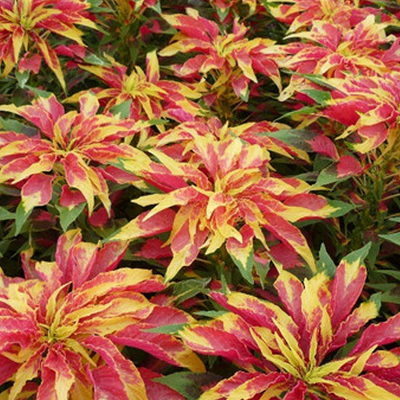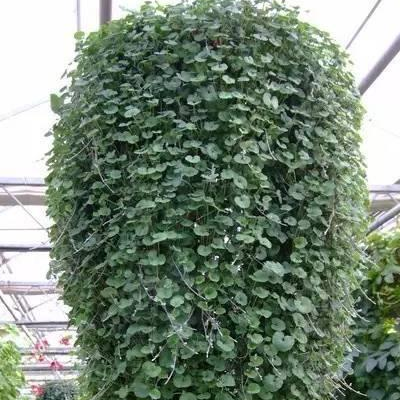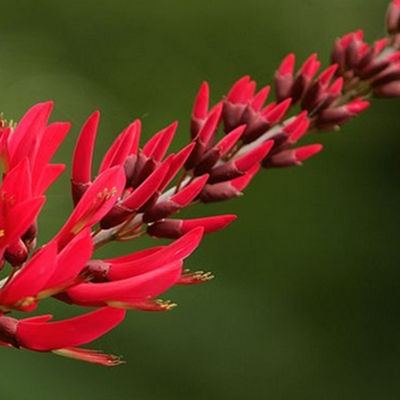How to raise Yanlai Red? is it poisonous?
Yanlaihong, the leaves of this plant can be a little different from those of ordinary plants. Let's take a look at how Yanlai Hong is raised. Is Yanlai Red poisonous?

How to raise Yan Laihong:
1. Soil
Yanlai red soil requirements are not strict, potted Yanlai red is generally the use of mixed soil, garden soil, rotten leaf soil and fine sand mixed, requiring loose, fertile and good drainage, with a certain degree of alkali resistance.
2. Light and temperature
Yanlaihong likes sunshine and needs to ensure sufficient light to grow vigorously during the growth period. the control of light within a certain period of time is helpful to the formation of flower buds. In terms of temperature, it is necessary to ensure that the growth temperature is between 18 ℃ and 25 ℃ to ensure a warm growth environment. Yan Laihong is not resistant to cold, and it is necessary to keep the overwintering temperature above 10 ℃ in winter.
3. Watering and fertilizing
Yanlaihong requires to maintain an adequate water supply during the growth period, and watering must be controlled. Keeping the basin soil moist will make the wild goose red stems and leaves grow well, but there may also be overgrowth, but there can be no lack of water. Although Yanlai red can withstand drought, it can not be too dry, which will make the wild goose red leaves yellow or even fall off. Fertilization does not need to be applied too much. Yanlaihong generally applies sufficient base fertilizer when planting, and it can be fertilized 2 Murray 3 times in the growing season to meet the needs of various growth elements.
Is Yanlai Red poisonous?
Yanlaihong is a kind of traditional Chinese medicine with good curative effect and no side effects.
This is the end of the introduction of the breeding method of Yanlai Hong. This Yanlai Hong is not poisonous, so hurry up to have one at home.
Is Catharanthus roseus poisonous? what is the flower language of Catharanthus roseus?
Catharanthus roseus is suitable for potted plants, and now many people raise Catharanthus roseus at home. Is the periwinkle poisonous? What is the function of Catharanthus roseus? what is the flower language of Catharanthus roseus? The following editor will introduce to you whether Catharanthus roseus is poisonous, the role of Catharanthus roseus and flower language.
Brief introduction of Catharanthus roseus
Catharanthus roseus (scientific name: Catharanthus roseus), also known as Richun, Asahi, Rixin, 30,000 Flowers, 04:00 Spring, Zhong Hua, Yanlahong, and so on. At present, many varieties have been bred in Taiwan, and in recent years there has been a growing trend in flower breeding.
Catharanthus roseus is a perennial herb with erect stems and much branched stems. Leaves opposite, long elliptic, petiole short, entire, both sides smooth glabrous, main vein white obvious. Cymes terminal. Flowers are red, purple, pink, white, yellow and other colors, Corolla butterfly-shaped, 5-lobed, there are dark holes in the center of the flower. At the top of the twigs of Catharanthus roseus, two flowers appear in the axils of each leaf, so it has many flowers, long flowering period, luxuriant and vibrant flowers. It blossoms non-stop from spring to autumn, so it has the reputation of "every day and spring".
Is Catharanthus roseus poisonous
Catharanthus roseus is a plant of oleander family. Like oleander, its juice is poisonous, among which flowers are the most toxic. But in general, it will only be poisoned when the wound touches the sap or eats the sap by mistake. Slightly touching the flowers and leaves of Catharanthus roseus will not cause harm to the human body, as long as we usually pay attention to it, do not break the branches and leaves casually. If you accidentally eat Catharanthus roseus, it will cause leukopenia, thrombocytopenia, muscle weakness, limb paralysis and other symptoms. Therefore, the editor suggests not to grow Catharanthus roseus indoors, which is neither safe nor good.
The function of Catharanthus roseus
1. Most of the alkaloids isolated from Catharanthus roseus have anti-tumor effects, among which vincristine and vincristine are the most valuable and have been used in clinic. The chemical structures of the two drugs were very similar, but the antitumor spectra were different, and there was no cross resistance between the two drugs.
2. Intravenous injection of total alkaloids has antihypertensive effect on anesthetized cats and rabbits, and the blood pressure decreases rapidly, which is the same as the slow hypotension of the preparation of total alkaloids, and the hypotension is accompanied by the deepening of breathing and the increase of amplitude.
3. The water extract of Catharanthus roseus leaves can also reduce blood glucose in normal and alloxan-induced diabetic rabbits and dogs.
4. The diuretic effect of Vindolinine in Catharanthus roseus on saline loaded rats.
5. The total alkaloid of Catharanthus roseus has no excitatory effect on isolated uterus and intestine, but has inhibitory effect on isolated heart in large dose. It can be used as hemostatic agent in uterine bleeding and its root can be used for abortion.
Catharanthus roseus florescence
Catharanthus roseus is an annual evergreen herb, tufted, slender stems, prostrate or procumbent, up to more than 1 meter long, leaves opposite, oval or ovate, apex acute, green, glossy, leaf margin and veins with golden yellow and gray-green markings, generally flowering from April to May, flowers solitary veins, blue, Corolla butterfly. The flowering period is very long, and it blossoms non-stop from spring to autumn, so it has the good name of "day and spring".
Catharanthus roseus
The words of Catharanthus roseus: happy memories, everlasting youth, steadfastness.
People looking for Catharanthus roseus are nostalgic and attach importance to friendship, especially their first lovers. although we all belong to each other, we are still unable to forget. I am conscientious and commendable in doing things.
The symbol of Catharanthus roseus: firmness.
Legend of Catharanthus roseus
There are many legends about Catharanthus roseus all over the world, among which it is said that the great thinker Rousseau likes flowers and plants very much. One day, he went for a walk by the river and found Catharanthus roseus, which reminded him of his happy past with his lover 30 years ago. According to legend, if men and women eat the leaves of Catharanthus roseus together in places that no one else can see, love will suddenly sprout.
After reading this article, I believe you have a certain understanding of Catharanthus roseus. It must be remembered that Catharanthus roseus is poisonous and must not be eaten by mistake. Is Catharanthus roseus poisonous? The role of Catharanthus roseus and the introduction of Hua Yu, I hope it can be helpful to everyone.
Catharanthus roseus flower words, Catharanthus roseus pictures
Catharanthus roseus, because it blossoms continuously from spring to autumn, has the reputation of "every day and spring". It is precisely so that it will be deeply loved and pursued by loved flowers, and today's Catharanthus roseus will also be widely used in indoor potted plants. as a higher ornamental plant flowers, I believe many friends will ask a breeding method, flower language and the role of flowers and so on. So the editor briefly introduces the relevant information of Catharanthus roseus here.
[plant archives]--
English name: Catharanthus roseus
Study: Herba Catharanthi rosei
Alias: daily spring, daily grass, daily new, 04:00 spring, clock flower, wild goose red, five-colored plum, four seasons flower, red periwinkle
Family: Apocynaceae
Genus: Catharanthus roseus
Growth environment: mostly on the edge of the forest, roadside, beach and garden grass, mostly for cultivation
Distribution of origin: originated from the Mediterranean coast, India, tropical America, in China's Guangdong, Guangxi, Yunnan and other provinces (autonomous regions) cultivation is more common.
Morphological features: perennial evergreen herbs. Clumpy, slender stems, prostrate or procumbent, up to more than 1 meter long, leaves opposite, elliptic or ovate, apex acute, green, shiny, golden yellow and gray-green markings between leaf margin and veins, flowering from April to May, flowers solitary, blue, Corolla butterfly-shaped.
[more Encyclopedia of plants]
The symbolic significance of lilies pictures of Platycodon grandiflorum flowers how to raise lover grass happiness tree picture moss how to raise radiation-proof flowers
Touch the fragrant fairy mountain cherry blossoms when to open potted grapes what plants absorb formaldehyde gardenia leaves yellow how to raise orchids
The culture method of Phoenix tail bamboo how to raise potted lotus money tree blossom radiation protection plant Begonia
[properties of traditional Chinese medicine]-
Bitter; cold; poisonous
Liver meridian
[efficacy] detoxification and anti-cancer; clearing away heat and calming the liver.
[indications] it mainly treats many kinds of cancer, hypertension, carbuncle, sore and scald.
[source of medicinal materials] is the whole grass of Catharanthus roseus and Catharanthus roseus.
Oral administration: fried soup, 5-10g; or made from extract
[medicinal parts] the shape is the same as Catharanthus roseus, only yellow flowers.
[harvest and storage] harvested from late September to early October of that year, the aboveground parts were harvested on a sunny day, first cut off the woody hard stem of the plant stem, and then cut the small segment of growing 6cm and dry it.
The main toxicity of vincristine is to inhibit the function of bone marrow, and vincristine is more toxic to nervous system and gastrointestinal tract, such as abnormal sensation, disappearance of knee reflex, myasthenia, neuralgia, alopecia and abdominal colic, intestinal obstruction, etc. however, it is much lighter to leukopenia and thrombocytopenia than vincristine.
[pharmacological action]-
1. Most of the alkaloids isolated from Catharanthus roseus have anti-tumor effects, among which vincristine and vincristine are the most valuable and have been used in clinic. The chemical structures of the two drugs were very similar, but the antitumor spectra were different, and there was no cross resistance between the two drugs.
two。 Intravenous injection of total alkaloids can reduce blood pressure in anesthetized cats and rabbits, and the blood pressure decreases rapidly, which is the same as the slow hypotension of total alkaloids, and the hypotension is accompanied by the deepening of breathing and the increase of amplitude.
3. The water extract of Catharanthus roseus leaves can also reduce blood glucose in normal and alloxan-induced diabetic rabbits and dogs.
4. The diuretic effect of Vindolinine in Catharanthus roseus on saline loaded rats.
5. The total alkaloid of Catharanthus roseus has no excitatory effect on isolated uterus and intestine, but has inhibitory effect on isolated heart in large dose. It is introduced abroad that total alkaloid of Catharanthus roseus can be used as hemostatic in uterine bleeding and its root can be used for abortion.
How to raise Catharanthus roseus? -
◆ growth habits: like dry, high temperature, ventilation, sunny environment, resistant to drought but not resistant to water and moisture.
◆ growth temperature: the optimum temperature for Catharanthus roseus growth is 18: 24 ℃ from March to July, 13: 18 ℃ from September to March of the following year, and the winter temperature is not lower than 10 ℃.
◆ storage place: sunny and slightly dry environment.
◆ sunlight demand: Catharanthus roseus is a positive plant, growth and flowering require sufficient sunlight, sufficient light is also conducive to prevent plant overgrowth. There is not enough sunshine in winter and the temperature drops, which is not conducive to growth.
◆ watering: Catharanthus roseus avoid dampness and fear of waterlogging, basin soil watering should not be too much, too wet affects growth and development. In particular, indoor winter plants should be strictly controlled watering, it is better to dry, otherwise it is easy to freeze. Open field cultivation, midsummer showers, pay attention to timely drainage, so as not to cause the whole area to die by waterlogging.
◆ fertilization: suitable for fertile and well-drained soil, resistant to barren soil, but do not be alkaline. Clayey soil with hardening and poor ventilation results in poor growth of plants, yellowing leaves and no flowering.
◆ potted soil: when Catharanthus roseus is cultivated, it is better to dry the potted soil.
◆ heart picking: Catharanthus roseus without heart picking has little effect on its own growth, but if it can pick the heart once or twice during the seedling period, it will make its plant shape more beautiful.
◆ pruning: usually we should also do a good job in pruning Catharanthus roseus, and cut off the old and weak branches in time, otherwise it not only affects the overall beauty but also consumes nutrients in vain.
◆ disease control: Catharanthus roseus plants are poisonous, so they are relatively resistant to diseases and insect pests. The main diseases in seedling stage are: seedling quenching disease, Botrytis cinerea and so on. In addition, it is necessary to prevent the occurrence of fertilizer damage and drug damage in seedling stage. If it happens, it should be watered with clean water immediately to strengthen ventilation and reduce the harm. The main pests are: red spiders, aphids, tea moths and so on. Long-term rain is very disadvantageous to Catharanthus roseus, especially susceptible to disease. Don't get caught in the rain during the production process.
The culture method of Catharanthus roseus
① cuttage propagation: cuttings should be tender and pay attention to heat preservation and moisture preservation during cutting.
The cutting time of Catharanthus roseus is usually in spring, and we try to cut off a relatively tender branch as a cutting. it can be a tender strip on a new branch or a new one on an old branch, always tender, with two or three leaves at the top, and then insert the bottom of the branch into the wet sand. Try to control the temperature between 20 and 25 degrees during cutting. after watering, you can cover the basin soil and cuttings with a film to moisturize, and put the basin soil in a cool, ventilated place to wait for rooting.
② Water plug Propagation: pay attention to changing water in summer.
The selection of water cuttings of Catharanthus roseus is similar to that of ordinary cuttings, and the truncated branches can be inserted directly into clear water, but always change water for cuttings, preferably every two days, to ensure the content and cleanliness of nutrients in clear water. When necessary, you can also add a few drops of nutrient solution to promote the rooting of water cuttings. Generally speaking, it takes about 20 days to take root.
The flower words of Catharanthus roseus-
Legend: there are many legends about Catharanthus roseus all over the world, among which it is said that the great thinker Rousseau likes flowers and plants very much. One day, he went for a walk by the river and found Catharanthus roseus, which reminded him of his happy past with his lover 30 years ago. According to legend, if men and women eat the leaves of Catharanthus roseus together in places that no one else can see, love will suddenly sprout.
The words of Catharanthus roseus: happy memories, everlasting youth, steadfastness!
Conclusion: nowadays, Catharanthus roseus has been widely used in indoor potted plants, but it is worth reminding everyone here that although Catharanthus roseus, which has the good name of "day and spring", belongs to the family Phyllostachys pubescens, it breaks its stems and leaves and gives off white milk, which is highly poisonous, so don't eat it by mistake!
- Prev

How to make a waterfall with Dichondra? can it be hydroponically cultivated?
Dichondra, this plant is super good-looking, if you can develop a large basin that is even more beautiful, how to develop a waterfall? Can Dichondra be hydroponically cultivated: how can Dichondra develop into a Waterfall: environment, the growth of Dichondra should maintain enough light, be exposed to more sunlight every day, and be well ventilated.
- Next

Is the culture method of Longya flower toxic?
Longya flower, this is a lot of people are super like, blooming flowers that is a string, is good to see do not want, what is the breeding method of longya flower? Is the dragon tooth flower poisonous: the culture method of the dragon tooth flower: the pot soil choice, the dragon tooth flower is the larger woody flower, the pot needs to choose the larger flowerpot.
Related
- Fuxing push coffee new agricultural production and marketing class: lack of small-scale processing plants
- Jujube rice field leisure farm deep ploughing Yilan for five years to create a space for organic food and play
- Nongyu Farm-A trial of organic papaya for brave women with advanced technology
- Four points for attention in the prevention and control of diseases and insect pests of edible fungi
- How to add nutrient solution to Edible Fungi
- Is there any good way to control edible fungus mites?
- Open Inoculation Technology of Edible Fungi
- Is there any clever way to use fertilizer for edible fungus in winter?
- What agents are used to kill the pathogens of edible fungi in the mushroom shed?
- Rapid drying of Edible Fungi

